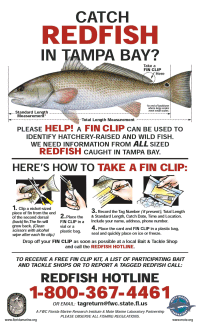|
 Tampa Bay anglers are being enlisted to help assess the impacts of hatchery-raised fish released into the wild by taking a nickel-size clip from the dorsal fin of any redfish they hook, packing it on ice, and returning the clip to a participating bait and tackle shop. Tampa Bay anglers are being enlisted to help assess the impacts of hatchery-raised fish released into the wild by taking a nickel-size clip from the dorsal fin of any redfish they hook, packing it on ice, and returning the clip to a participating bait and tackle shop.
A DNA "fingerprint" from the fin clip lets scientists identify and track hatchery-raised fish and offspring, while supplemental information provided by fishermen yields valuable data on the age, growth and distribution of redfish.
Part of Project Tampa Bay, the Florida Fish and Wildlife Conservation (FWC) Commission's efforts to raise and release redfish fingerlings to replenish stocks in Tampa Bay, participating anglers will receive small prizes for every fin clip returned, plus a chance to win tackle and rods in quarterly drawings. However, participation may be its own best reward, says FWC Hatchery spokeswoman Gina Russo. "By helping us catch and clip reds, anglers are helping us put more fish in the water." Both Project Tampa Bay and the Fin Clip Reward project are funded by saltwater fishing license revenues.
Fin clip kits can be obtained by calling the Redfish Hotline at 1-800-367-4461. Each kit contains instructions, a small pair of scissors, a fin clip bag with pencil and card for recording basic information, and a list of participating bait-and-tackle shops.
In 1999, FWC and Mote Marine Laboratory began a large-scale redfish stock enhancement project in Tampa Bay to increase recreational catches and determine the best and most cost-effective methods and locations for stocking. Approximately 1.7 million redfish fingerlings (about 1.5 inches long) were released into the Alafia and Little Manatee rivers, where 85 percent of the bay's juvenile redfish population resides. Those fish are just now maturing. Hatchery officials believe stocking can be a cost-effective addition to fisheries management tools such as regulation and habitat protection and enhancement. If hatchery-raised fish can substantially enhance wild populations, they say, increased bag limits can be justified.
The marine hatchery is located on Tampa Bay in northwest Manatee County. Stocking in locations near the hatchery reduces stress on the animals and increases their chances for survival. Scientists from Mote and FWC's Florida Marine Research Institute have been monitoring fisheries in Tampa Bay for years, enabling them to document the abundance of redfish before and after stocking efforts.
For more information, contact FWC's Stock Enhancement Research Facility at Port Manatee, 941-723-4505, or call the Redfish Hotline at 800-367-4461.
Top
|